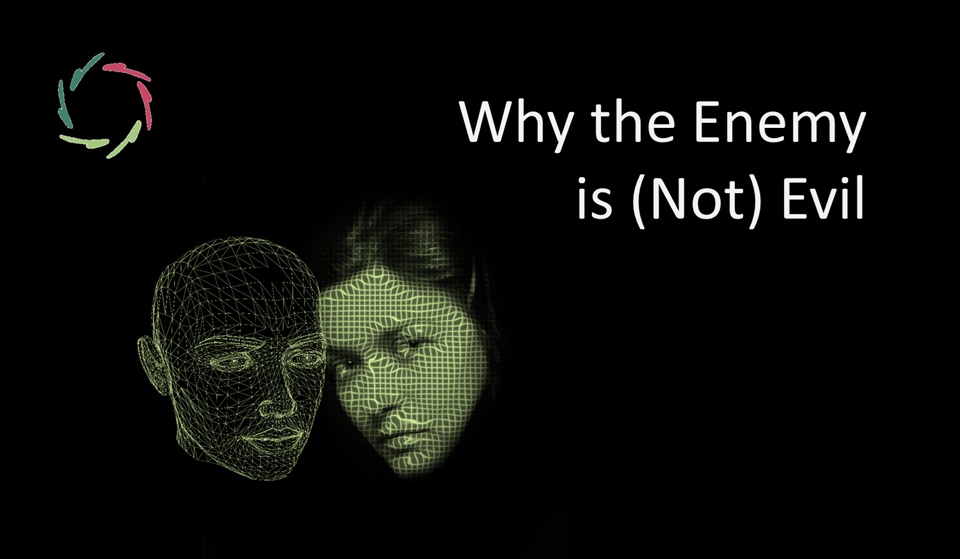Why the Enemy is (Not) Evil

We all meet opposition, sometimes true danger. Yet there’s a difference between defending ourselves and declaring the other evil.
Evil simplifies life by dividing it into light and darkness, but this false clarity blinds us. The challenge is to stay human in the face of threat — to protect without projecting, to see complexity without losing courage.
Enemies, yes; ‘evil,’ no
Fear, defense, and the showing of strength can be wise responses. But when fear hardens into the belief that the enemy is evil, understanding stops. As explored in The Enemy Complex, this projection freezes growth and feeds hatred.
Seeing ‘evil’ turns reality into a mythic battlefield. The other becomes an abstraction, stripped of story and nuance. Dialogue dies; curiosity feels like betrayal. Evil offers clarity without depth — the beginning of possible cruelty.
The creation of evil
The enemy is frequently made out of fear, anxiety, and the need for internal unity. In times of stress, people long for cohesion, and nothing unites more quickly than a shared adversary. Yet unity born of hatred is fragile.
As shown in Creating the Enemy, societies project their unresolved inner conflict outward. The ‘evil one’ becomes a screen for what we refuse to face inside. When projection replaces self-insight, anxiety feels relieved for a moment, but the deeper wound widens.
Cognitive layer – the mind’s mirror
The mind seeks simplicity: good here, evil there. Each label narrows perception until only confirmation remains. This self-reinforcing loop – fear feeding untoward certainty, untoward certainty feeding blindness and more fear – is a cognitive vicious circle.
The virtuous alternative begins with not-knowing. When we hold questions rather than answers, curiosity re-enters, and the loop reverses. As Good versus Evil argues, the humane task is not to win the battle between opposites but to transcend it. Intelligence deepens only when it stays open.
Emotional layer – fear, anxiety, and projection
Fear is concrete; anxiety is symbolic. Fear protects us from danger. Anxiety signals disconnection inside. When anxiety is ignored, it turns outward as aggression — a process described in From Anxiety to Aggression.
To call someone evil is often to translate inner unease into outer violence. Fear can be resolved through intelligent action; anxiety asks for listening. Compassion means the courage to face one’s own trembling until it finds meaning. Only then does the urge to attack subside.
Anxiety, when heard, becomes energy for growth. Unheard, it fuels the myth of evil.
Societal layer – from polarization to dialogue
When a society projects its anxiety, ‘enemy creation’ becomes policy. Collective fear spreads like inflammation. Research discussed in Is Social Nocebo Real? shows how shared negative expectations can harm collective health as surely as infection.
Social narratives can inflame or regulate. Social Psychosomatic Science describes how public stories either strengthen or weaken a community’s resilience. Demonizing others may forge quick cohesion, but it depletes trust. Dialogue, empathy, and transparency work as healing mediators.
At this scale, ‘evil mongering’ becomes cultural autoimmunity: society attacking itself in the name of purity.
Immunological layer – the wisdom of listening
The healthy immune system is not a warrior but a listener. It discerns differences without hatred. When it listens well, the body remains in harmony; when it stops listening, disease begins.
Each kind of immune disorder mirrors a human pattern:
- Allergy resembles fear — harmless things treated as threats.
- Autoimmunity echoes polarization — the self destroying itself.
- Infection shows depletion — inner conflict draining defense.
- And cancer mirrors arrogance — the cell that shouts the loudest, forgetting humility.
As Mind and Immunology notes, healthy immunity depends on communication. ‘Immunological wisdom’ means strength through coherence: defending without dehumanizing. The same principle can guide societies and souls.
Evil as absence
What if evil is not a force but a failure — not something dark and powerful, but something missing? When the bridges between thought and feeling, self and other, collapse, a vacuum opens. Anxiety fills it; aggression follows.
Evil, in this view, is the echo of lost connection. Spinoza called it the absence of good; Jung saw it as the unacknowledged shadow. Systems theory calls it feedback failure. All agree: the cure is reconnection. As Does Evil Exist? suggests, evil vanishes wherever integration returns. Evil ends not with destruction but with understanding. Where there is listening, evil cannot breathe.
Vicious and virtuous circles
Suffering, whether physical or social, often takes the shape of a whirlpool. Energy turns inward, trying to fix itself, yet only deepening the spiral. Whirlpool of Disease and Whirlpool Phenomenon in Societal Inner Dissociation show the same pattern: correction lost in overcorrection.
The way out is awareness. When even one point in the vortex regains orientation toward wholeness, the flow reverses. The same current that destroyed now heals. Evil, too, can be converted — not by fighting it, but by changing its direction.
The courage to listen
Anxiety is not the enemy; it is a voice waiting to be understood. When silenced, it becomes aggression. Every atrocity begins this way: unmet anxiety projected outward, de-humanized, and justified. Evil lives only as long as we feed it.
Listening is the act that breaks the spell. Fear can protect, but only understanding heals. The opposite of evil is not good — it is growth. Growth through dialogue, humility, and Compassion: the quiet courage to remain open when closing would feel safer.
As long as there is listening, there can be learning; as long as there is learning, there can be love.
The temptation of false clarity
Evil promises simplicity. It offers certainty without truth. Yet freedom lives within complexity. The mature soul does not divide the world into light and dark but learns to see in twilight.
Humanity will outgrow evil when trembling becomes understanding.


